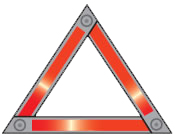Unfortunately, crashes do happen on our roads. As a responsible driver, you need to know the signs that show you are coming up to the scene of a crash and what your responsibilities are if you’re involved in a crash or if you come across a crash.
At a crash site, the police may use signs, flashing lights and flares to warn approaching drivers.
When coming up to a crash site, slow down and drive carefully. The road may be blocked and there could be injured people lying on it.

Crash sign

Crash sign

Crash sign
The signs shown above are placed by police near a crash site. They mean you must drive at 20km/h or less until you pass the crash site. Watch out for emergency workers and injured people.

Warning triangle
The triangle shown above is a warning triangle. It means there is a breakdown or crash ahead. Anyone can put a warning triangle on the side of the road to warn other road users.
If you are involved in a crash while driving, and you are not badly injured, the first thing you must do is stop and check to see if anyone is hurt, and provide assistance.
If someone is hurt, you must tell a police officer as soon as possible and no later than 24 hours after the crash.
If no one is hurt, you must give your name, address and vehicle registration (and, if asked, the name and address of the owner of the vehicle you are driving, if it isn’t your vehicle) as soon as possible but no later than 48 hours after the crash to:
If you can’t find these people, you must tell a police officer as soon as possible and no later than 60 hours after the crash.
If your vehicle is insured, tell your insurance company as soon as possible after the crash.
If you are first on the scene of a crash, your actions could help save the lives of the people involved in the crash and make it safer for other drivers coming upon the crash scene.
Here are some things you can do to help make the crash scene safer:
If people have been injured in the crash, you should call an ambulance as soon as you can. Before the ambulance comes, there are some things you may be able to do to help them and some things you should be aware of, which are outlined in the basic first aid section.
Ideally, you should enrol in a recognised first aid course so you can learn techniques such as cardiopulmonary resuscitation (CPR) and mouth-to-mouth resuscitation under proper supervision. This will make you more confident and more capable of using first aid if you have to.
If a victim has spinal injuries, moving them may only worsen their injuries. You should never move a crash victim unless it is absolutely necessary. The only instances where you should move someone before medical help arrives are when:
If the crash victim is a motorcyclist, you should never remove their helmet.
If the patient is bleeding badly, you should try to stop or reduce the bleeding.
If you come across a crash involving a vehicle that is carrying dangerous goods, you will need to be extremely careful. Never make a rescue attempt unless you are sure you are not endangering yourself by coming into contact with dangerous substances.
Most vehicles carrying dangerous goods display a placard that indicates the type of goods being carried.
Remember, if you’re at a crash site and you’re in any doubt about the meaning of a placard, keep your distance – especially if there’s been a spillage. Poisonous fumes may be given off by a dangerous substance.
Make a careful note of the colour and symbol on the placard and give this information to the emergency services when phoning to report a crash and when they arrive at the crash site. Keep bystanders well away from the crash scene and upwind of poisonous fumes.